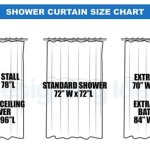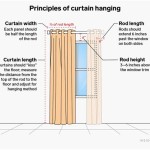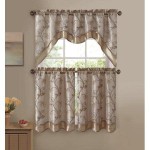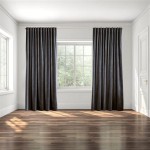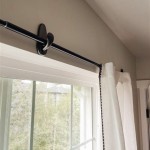How To Install Curtains Without a Drill
Installing curtains can dramatically enhance the aesthetic appeal and functionality of a living space. However, the prospect of drilling holes into walls can be daunting, particularly for renters, those concerned about damaging surfaces, or individuals simply seeking a quicker and less invasive solution. Fortunately, several effective methods exist for installing curtains without the use of a drill. These methods leverage innovative hardware and techniques to provide secure and stylish window coverings.
This article provides a comprehensive guide to installing curtains without a drill, exploring various options, their suitability for different situations, and practical steps for successful implementation. It aims to equip individuals with the knowledge necessary to achieve their desired window treatment without compromising the integrity of their walls.
Understanding the Available Options
Before embarking on the installation process, it is crucial to understand the range of drill-free curtain hanging solutions available. Each option possesses unique strengths and weaknesses, making it suitable for specific curtain types, window frames, and wall materials. A careful assessment of these factors will ensure the selection of the most appropriate and effective method.
Tension Rods: Tension rods are a classic and versatile option for hanging lightweight curtains. They rely on spring-loaded mechanisms to create pressure between two surfaces, typically the inside of a window frame or a door frame. These rods are adjustable in length, allowing for a custom fit within the desired space.
Adhesive Hooks and Rods: Adhesive hooks and rods utilize strong adhesives to adhere to the wall surface. These options are ideal for lightweight to medium-weight curtains and are particularly suitable for smooth, non-porous surfaces like tiles, glass, and metal. The adhesive strength varies depending on the product, so it is essential to choose an option with sufficient weight capacity for the intended curtains.
Magnetic Curtain Rods: Magnetic curtain rods are designed for metal surfaces, such as steel doors and window frames. They utilize strong magnets to attach to the metal, providing a secure and adjustable hanging solution. These rods are particularly useful in workshops, garages, or other spaces with exposed metal surfaces.
No-Drill Curtain Rod Brackets: These brackets are specifically designed to attach to the existing trim or molding around a window frame. They typically use pressure or clamping mechanisms to secure themselves without requiring any drilling or screws. No-drill brackets are a good option for those seeking a more permanent and aesthetically pleasing solution than tension rods or adhesive hooks.
Command Hooks: Command hooks, while primarily designed for general hanging purposes, can also be adapted for curtain hanging. By strategically placing multiple hooks and using curtain rings or clips, lightweight curtains can be effectively suspended. These hooks are easy to install and remove, making them a popular choice for temporary or damage-free solutions.
Preparing for Installation
Regardless of the chosen method, thorough preparation is essential for a successful and aesthetically pleasing curtain installation. This preparation involves gathering the necessary materials, cleaning the surfaces, and accurately measuring the window or door frame.
Gathering Materials: The required materials will vary depending on the chosen installation method. Generally, it will include the selected curtain rod or hanging system, curtains, measuring tape, a level (optional but recommended), cleaning supplies (such as rubbing alcohol and a clean cloth), and any necessary tools, such as scissors or a step stool.
Cleaning the Surfaces: Thoroughly cleaning the surfaces where the curtain rod or hanging system will be attached is crucial for ensuring a strong and durable bond. Use rubbing alcohol or a similar cleaning agent to remove any dirt, grease, or residue. Allow the surface to dry completely before proceeding with the installation.
Measuring and Marking: Accurate measurements are essential for ensuring that the curtains hang evenly and at the desired height. Use a measuring tape to determine the desired length and width of the curtains, as well as the placement of the curtain rod or hanging system. Use a pencil to lightly mark the desired locations on the wall or window frame. A level can be used to ensure that the marks are aligned horizontally.
Curtain Preparation: Ensure the curtains are properly prepared before installation. This may involve ironing out any wrinkles or attaching curtain rings or clips as needed, based on the design and hanging style of the curtains.
Step-by-Step Installation Guides for Different Methods
The specific installation steps will vary depending on the selected method. The following sections provide detailed instructions for installing curtains using some of the most common drill-free methods.
Installing Curtains with Tension Rods:
- Extend the tension rod slightly longer than the width of the window or door frame.
- Compress the rod and carefully position it inside the frame at the desired height.
- Release the rod, allowing it to expand and create pressure against the frame.
- Adjust the rod until it is level and securely in place.
- Hang the curtains on the rod using the appropriate rings or loops.
Installing Curtains with Adhesive Hooks and Rods:
- Clean the surface thoroughly with rubbing alcohol and allow it to dry completely.
- Peel off the backing from the adhesive hooks or rod and carefully position them on the wall at the marked locations.
- Press firmly on the hooks or rod for the recommended amount of time to ensure a secure bond.
- Allow the adhesive to cure for the recommended time (usually 24-48 hours) before hanging the curtains.
- Hang the curtains on the rod using the appropriate rings or loops.
Installing Curtains with Magnetic Curtain Rods:
- Clean the metal surface thoroughly.
- Position the magnetic curtain rod to the desired location.
- Ensure the magnets are firmly attached to the metal.
- Hang the curtains. The magnets should support the weight of the curtains.
Installing Curtains with No-Drill Curtain Rod Brackets:
- Position the brackets on the window frame trim.
- Tighten the clamping mechanisms or pressure screws until the brackets are securely attached.
- Ensure the brackets are level and aligned.
- Insert the curtain rod into the brackets.
- Hang the curtains.
Installing Curtains with Command Hooks:
- Clean the wall surface thoroughly with rubbing alcohol and allow it to dry completely.
- Attach the Command strips to the backs of the hooks, following the manufacturer's instructions.
- Position the hooks on the wall at the marked locations, ensuring they are evenly spaced and aligned.
- Press firmly on the hooks for the recommended amount of time to ensure a secure bond.
- Allow the adhesive to cure for the recommended time (usually 1 hour) before hanging the curtains.
- Attach curtain rings or clips to the curtains.
- Hang the curtains from the Command hooks. Note: This method works best for very lightweight curtains.
Important Considerations: It is crucial to adhere to the manufacturer's instructions for each specific product. Weight limits should be strictly observed to avoid damage or failure. Regular inspection of the installation is advised to ensure ongoing stability and security.
For heavier drapes, consider using multiple adhesive hooks rated for higher weight tolerance, but even then, the overall holding power is likely to be less than a drilled and screwed bracket. If uncertain, testing the adhesive or the bracket beforehand with a moderate weight can prevent mishaps.
The type of wall material also impacts the suitability of using adhesive methods. Textured walls or walls covered in wallpaper might not provide an ideal surface for adhesive to effectively stick. Similarly, older paint that is peeling or flaking can compromise the adhesive's bonding strength.
When using tension rods, ensure the surface is clean and dry to maximize the grip. For added security, consider using rubber or silicone pads at the contact points between the rod and the frame to prevent slippage, particularly in areas prone to humidity or temperature fluctuations.
Finally, consider the aesthetic appeal of the chosen method. While functionality is paramount, the installation should complement the overall decor of the room. Opting for brackets or rods that match the existing color scheme or style can elevate the look and create a more cohesive design.

How To Hang Curtains Without Drilling

How To Hang A Curtain Rod Without Drilling Into The Wall

5 Easy Ways To Hang Curtains Without Drilling

How To Hang Curtains Without Drilling 2 Solutions

5 Easy Ways To Hang Curtains Without Drilling

How To Hang Curtains Without Drilling 2 Solutions

How To Hang Curtains Without Drilling 2 Solutions

5 Easy Ways To Hang Curtains Without Drilling

How To Hang A Curtain Rod Without Drilling Into The Wall

Er Friendly Curtains How To Hang Them Without Drilling Draper And Kramer Incorporated


